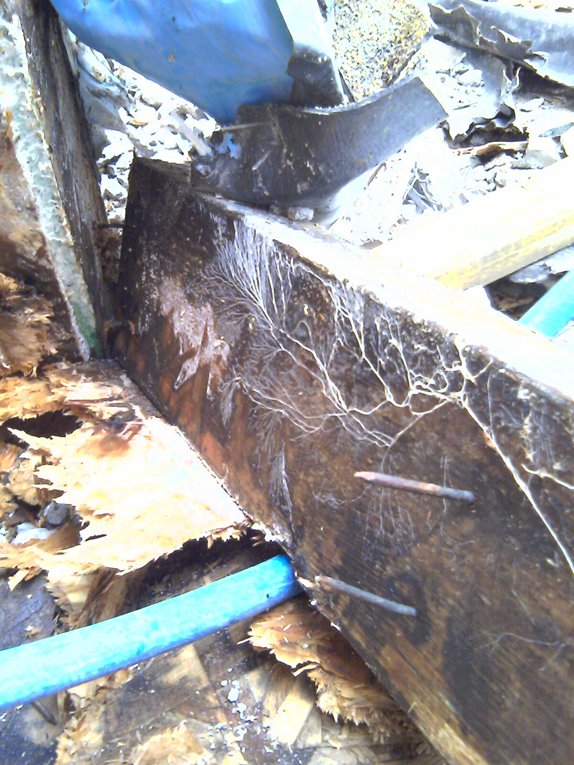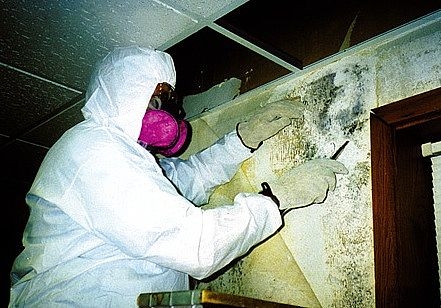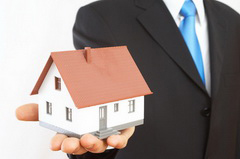MOLD Remediation
Assessment
The first step in an assessment is to determine if mold is present. This is done by one of our certified inspectors, visually examining the premises. If mold is growing and visible this helps determine the level of remediation that is necessary. If mold is actively growing and is visibly confirmed, sampling for specific species of mold is unnecessary.
These methods, considered non-intrusive, only detect visible and odor-causing molds. Sometimes more intrusive methods are needed to assess the level of mold contamination. This would include moving furniture, lifting and/or removing carpets, checking behind wallpaper or paneling, checking in ventilation duct work, opening and exposing wall cavities, etc.
Careful detailed visual inspection and recognition of moldy odors should be used to find problems needing correction. Efforts should focus on areas where there are signs of liquid moisture or water vapor (humidity) or where moisture problems are suspected. The investigation goals should be to locate indoor mold growth to determine how to correct the moisture problem and remove contamination safely and effectively.

The basic goals of any mold investigation are always twofold: 1) find the locations of mold growth, and 2) determine the sources of the moisture. If these can be answered by simpler or more cost-effective methods, mold testing is probably not a wise use of resources.
REMOVAL
The first step in solving an indoor mold problem is stopping the source of moisture. Next is to remove the mold growth. Common remedies for small occurrences of mold include:
- Sunlight
- Ventilation
- Non-porous building materials
- Household cleansers
Significant mold growth may require professional mold remediation and removal of affected building materials. A conservative strategy is to discard any building materials saturated by the water intrusion or having visible mold growth. There are many ways to prevent mold growth. In extreme cases of mold growth in buildings, it may be easier to condemn the building rather than clean the mold to safe levels. PRIME is capable of repairing mold damage - usually by removing the affected areas and eliminating the cause of the excess moisture.
Improper methods for cleaning mold include exposure to high heat, dry air, sunlight (particularly UV light), ozone, and application of fungicides. These methods may render the mold non-viable, however, the mold and its by-products can still elicit negative health effects. The only proper way to clean mold is to use detergent solutions that physically remove mold. Many commercially available detergents marketed for mold clean-up also include an anti-fungal agent. The most effective way at this point is formal Mold Remediation.
The goal of remediation is to remove or clean contaminated materials in a way that prevents the emission of fungi and dust contaminated with fungi from leaving a work area and entering an occupied or non-abatement area, while protecting the health of workers performing the abatement.
Cleanup methods
The purpose of the clean-up process is to eliminate the mold and fungal growth and to remove contaminated materials. As a general rule, simply killing the mold with a biocide is not enough. The mold must be removed since the chemicals and proteins, which cause a reaction in humans, are still present even in dead mold.
Vacuum
Wet vacuum cleaners are designed to remove water from floors, carpets and other hard surfaces where water has accumulated. Wet vacuuming should only be used on wet materials, as spores may be exhausted into the indoor environment if insufficient liquid is present. After use this equipment must be thoroughly cleaned and dried as spores can adhere to the inner surfaces of the tank, hoses, and other attachments.
Damp wipe
Damp wipe is the removal of mold from non-porous surfaces by wiping or scrubbing with water and a detergent. Care must be exercised to make sure the material is allowed to quickly dry to discourage any further mold growth. With surfaces such as metal, glass, hardwood, plastics, and concrete, you should scrape off as much of the mold as possible. Then, scrub the surface with a moldicide or fungicide cleaner.
HEPA vacuum
High Efficiency Particulate Air filtered vacuum cleaners are used in the final cleanup of remediation areas after materials have been thoroughly dried and all contaminated materials have been removed. HEPA vacuum cleaners are recommended for the cleanup of the outside areas surrounding the remediation area. During this process the workers wear proper personal protective equipment (PPE) to prevent exposure to mold and other contaminants. The collected debris and dust is stored in impervious bags or containers in a manner to prevent any release of debris.
Disposal of debris and damaged materials
Building materials and furnishings contaminated with mold should be placed into impervious bags or closed containers while in the remediation area. These materials can usually be discarded as regular construction waste.

Protection levels
During the remediation process, the level of contamination dictates the level of protection for the remediation workers. The levels of contamination are described as Levels I, II, and III. Each has specific requirements for worker safety. The levels are as follows:
Level I
Small Isolated Areas (10 sq. ft or less) for example, ceiling tiles, small areas on walls.
- Remediation can be conducted by the regular building staff as long as they are trained on proper clean-up methods, personal protection, and potential hazards. This training can be performed as part of a program to comply with the requirements of OSHA Hazard Communication Standard ( 29 CFR 1910.1200).
- Respiratory protection (for example, N-95 disposable respirator) is recommended. Respirators must be used in accordance with the OSHA respiratory protection standard (29 CFR 1910.134). Gloves and eye protection should also be worn.
- The work area should be unoccupied. Removing people from spaces adjacent to the work area is not necessary, but is recommended for infants (less than 12 months old), persons recovering from recent surgery, immune-suppressed, or people with respiratory diseases.
- Containment of the work area is not necessary. However, misting and dust suppression is recommended.
- Contaminated materials that cannot be cleaned should be removed from the building in sealed impermeable plastic bags and disposed of as ordinary waste.
- The work area/areas used by workers for access/egress should be cleaned with a damp cloth or mop and a detergent.
- All areas should be left dry and visibly free of contamination and debris.
Level II
Mid-sized Isolated Areas (10-30 sq ft) – for example, individual wallboard panels.
- Remediation can be conducted by the regular building staff as long as they are trained as for Level I. Respiratory protection, occupation of the work and adjacent areas, and handling of contaminated materials are the same as for Level I.
- Surfaces in the work area that could become contaminated should be covered with sheet(s) of plastic that are secured in place. This should be done prior to any remediation process to prevent further contamination.
- Dust suppression methods, such as misting (not soaking) surface prior to remediation, are recommended.
- The work area/areas used by workers for access/egress should be HEPA vacuumed and cleaned with a damp cloth or mop and a detergent.
- As with Level I, all areas should be left dry and visibly free of contamination and debris.
Level III
Large Isolated Areas (30-100 sq ft) – e.g., several wallboard panels
- It is recommended that personnel be trained in the handling of hazardous materials and equipped with respiratory protection (N-95 disposable respirator). Respirators must be used in accordance with OSHA respiratory protection standard (29 CFR 1910.134) Gloves and eye protection should also be worn.
- Surfaces in the work area and areas directly adjacent that could become contaminated should be covered with a secured plastics sheet(s) before remediation to contain dust/debris and prevent further contamination.
- Seal ventilation ducts/grills in the work area and areas directly adjacent with plastic sheeting.
- The work area and areas directly adjacent should be unoccupied. Removing people from spaces adjacent to the work area is not necessary, but is recommended for infants (less than 12 month old), persons recovering from recent surgery, immune-suppressed or people with respiratory diseases.
- Dust suppression methods, such as misting (not soakings) surface prior to remediation, are recommended.
- Contaminated materials that cannot be cleaned should be removed from the building in sealed impermeable plastic bags and disposed of as ordinary waste.
- The work area/areas used by workers for access/egress should be HEPA vacuumed and cleaned with a damp cloth or mop and a detergent.
- All areas should be left dry and visibly free from contamination and debris.
Level IV
Extensive Contamination (greater than 100 contiguous sq. ft in an area).
- Personnel trained in handling of hazardous materials and equipped with:
- Full face respirators with HEPA cartridges
- Disposable protective clothing covering the entire body including the head, shoes and hands
- Containment of the affected area:
- Complete isolation of the work area from occupied spaces using plastic sheeting sealed with duct tape ( including ventilation duct/grills, fixtures, and other openings
- The use of an exhaust fan with a HEPA filter to generate negative pressurization, a decontamination room, and airlocks
- Contaminated materials that cannot be cleaned should be removed from the building in sealed impermeable plastic bags and disposed of as ordinary waste.
- The contained area and decontamination room should be HEPA vacuumed and cleaned with a damp cloth or mopped with a detergent solution and be visibly clean prior to the removal of any isolation barrier.
In conclusion, after the moisture source has been eliminated and the mold growth removed, the premises should be revisited and then re-evaluated to ensure the mold growth and the remediation process was successful. The premises should be free of any moldy smells or visible growth. If you suspect you have an infestation, you should contact us as soon as possible.

Call or send an email.

